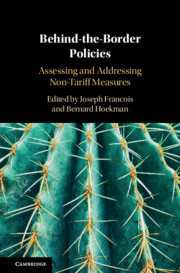Book contents
- Behind-the-Border Policies
- Behind-the-Border Policies
- Copyright page
- Contents
- Figures
- Tables
- Boxes
- Contributors
- 1 Moving beyond the Border
- Part I Concepts and Measurement
- Part II Assessing and Benchmarking Policy
- Part III Dealing with Non-tariff Measures: Legal and Institutional Contexts
- 8 Nontariff Measures Reforms
- 9 Good Regulatory Practices and International Trade
- 10 Rules of Origin as Non-tariff Measures
- 11 Behind-the-Border Measures and the New Generation of Trade Agreements
- 12 Nontariff Responses to China’s Development Strategy
- 13 A Time for Action
- References
- Index
13 - A Time for Action
The WTO Must Change to Promote Regulatory Cooperation
from Part III - Dealing with Non-tariff Measures: Legal and Institutional Contexts
Published online by Cambridge University Press: 25 October 2019
- Behind-the-Border Policies
- Behind-the-Border Policies
- Copyright page
- Contents
- Figures
- Tables
- Boxes
- Contributors
- 1 Moving beyond the Border
- Part I Concepts and Measurement
- Part II Assessing and Benchmarking Policy
- Part III Dealing with Non-tariff Measures: Legal and Institutional Contexts
- 8 Nontariff Measures Reforms
- 9 Good Regulatory Practices and International Trade
- 10 Rules of Origin as Non-tariff Measures
- 11 Behind-the-Border Measures and the New Generation of Trade Agreements
- 12 Nontariff Responses to China’s Development Strategy
- 13 A Time for Action
- References
- Index
Summary
Widespread recognition that international cooperation is needed does not in and of itself mean that it will occur. This was one of the lessons for trade integration in the interwar period, when governments were unable through proclamations and solo measures alone to arrest the cycle of retaliation that followed the US Smoot-Hawley Tariff Act of 1930, resulting in high tariff levels and rising tensions among the major powers. It is that experience that demonstrated the destructive potential of unilateralism in the trading system and led former US Secretary of State and Nobel Prize winner Cordell Hull and others to negotiate the General Agreement on Trade and Tariffs (GATT). Its rationale – or “GATT-think” – was that reciprocal liberalization would curb unilateral protection and the negative externalities that result from uncoordinated and nontransparent actions in a trading system with many partners (Bagwell and Staiger, 2002). In Hull’s thinking, trade liberalization dovetailed with peace, which was his overarching ambition.
- Type
- Chapter
- Information
- Behind-the-Border PoliciesAssessing and Addressing Non-Tariff Measures, pp. 299 - 338Publisher: Cambridge University PressPrint publication year: 2019

